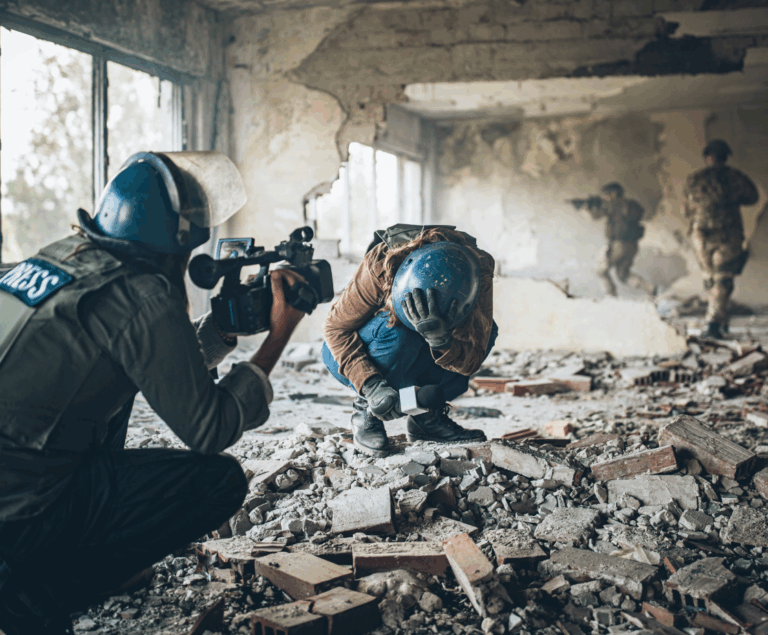The Taliban’s full control of Afghanistan since August 2021 has shown just how vital Noncombatant Evacuation Operations (NEOs) are for protecting civilians in crisis zones.
NEOs are conducted to evacuate civilians from foreign countries facing extreme threats such as war, natural disasters, or political instability. These missions require rapid force deployment, temporary control of key locations, and orderly withdrawal—all while staying within legal and diplomatic boundaries.
As global instability rises, emergency evacuations are becoming more common and complex. Diplomats, aid workers, and overseas staff must be prepared.
The scale of the Afghanistan NEO in 2021 showed the intensity of these operations, with plans aiming to relocate over 70,000 people to safe countries while they awaited visa processing.
This article walks you through the essential elements of planning and executing successful NEOs—just a glimpse into the more comprehensive approach taught in our full Noncombatant Evacuation Operations (NEO) online course.
Understanding the Purpose of NEOs
NEOs are designed to protect and remove civilians from life-threatening situations abroad—such as war, civil unrest, natural disasters, or rapid political collapse. The primary purpose is to safely extract citizens and approved individuals when staying in-country becomes too dangerous.
NEOs are not combat operations. They are diplomatically-led missions, supported by military forces, where the goal is civilian safety. The Chief of Mission (COM), typically an ambassador, holds overall responsibility for deciding when and how the evacuation takes place. Military units provide the logistics, security, and transport, but always under civilian direction unless emergency conditions require a temporary shift.
NEOs may involve a variety of evacuation methods:
- Airlift – Using civilian or military aircraft to fly evacuees out of the crisis zone
- Sealift – Naval vessels transport evacuees to safe havens by sea
- Ground Transport – Used when air or sea options are not available or too risky
Ultimately, the purpose of NEOs is to preserve life, maintain diplomatic credibility, and prevent wider instability. These operations depend on seamless coordination between embassies, military forces, and host nation partners.
When and Why NEOs Are Conducted
NEOs are launched when a deteriorating situation makes it unsafe for foreign nationals to remain. Triggers include:
- Civil unrest or political instability
- Armed conflict or terrorism
- Coups or power struggles
- Natural disasters
- Industrial or environmental emergencies
The Chief of Mission makes the initial decision, requesting evacuation support through official channels. Once approved, the military may be tasked to assist under defined legal agreements.
Citizens of the evacuating country take priority, followed by designated foreign nationals and local partners, based on operational capacity and humanitarian need.
Types of NEO Environments
NEO operations are shaped by the level of threat in the operating environment. Military planners classify these environments based on the likelihood of interference, which determines the size and nature of the evacuation force required:
- Permissive Environment: The host nation maintains full control and supports the evacuation. There is no expected resistance. In these operations, military forces focus on logistics, transport, medical care, and administrative processing, rather than combat or security operations.
- Uncertain Environment: While the host nation may be cooperative, it lacks full control of the territory or population. Civil authorities cannot guarantee the safety of evacuees. This environment requires additional force protection, including quick reaction forces and enhanced security planning.
- Hostile Environment: The host nation has lost control or actively opposes the evacuation. Law and order may have broken down, with threats ranging from riots and terrorism to open conflict. Military forces may need to secure landing zones, escort convoys, establish defensive positions, or even conduct personnel recovery under fire.
Each NEO presents different challenges. Success depends on flexible planning and the ability to scale operations based on the security environment and diplomatic direction.
Legal and Diplomatic Frameworks
NEOs operate within sensitive legal and diplomatic boundaries.
International Law and Sovereignty
NEOs must balance urgency with respect for territorial integrity. Article 2(4) of the UN Charter prohibits the use of force against sovereign nations. Therefore, several legal bases may be invoked:
- Host Nation Consent (preferred)
- UN Security Council Authorisation
- Self-Defence (Article 51)
- Protection of Nationals (debated)
Diplomatic Considerations
Military planners work closely with diplomatic authorities to secure overflight rights, host nation agreements, and staging access. The Chief of Mission must also consider political fallout or sovereignty concerns tied to military action.
Authority of the Chief of Mission
The Chief of Mission oversees the entire evacuation effort. Their responsibilities include:
- Deciding when to evacuate
- Coordinating with host nations and allied forces
- Ensuring safe and legal movement of personnel
Military units support the operation but remain under their own command structures unless otherwise required for tactical reasons.
Formal Agreements
Most governments have interagency agreements outlining NEO responsibilities. These define:
- Civilian vs military roles
- Support for non-citizens
- Use of foreign bases and overflight rights
Countries often collaborate through alliances like NATO or regional partnerships to assist each other’s citizens during evacuations.
Planning a NEO Step-by-Step
NEOs require careful preparation long before a crisis unfolds. While every operation is different, the key to success is having a detailed plan that covers each stage—from early warning signs to post-evacuation support.
Effective NEO planning includes:
- Threat assessment and updated Emergency Action Plans (EAPs)
- Pre-crisis coordination with host nations and allied partners
- Evacuee prioritisation, tracking systems, and assembly site preparation
- Transport logistics across air, sea, and land routes
- The establishment of Intermediate Staging Bases (ISBs) and Temporary Safe Havens
- Advance reconnaissance by Forward Command Elements and survey teams
- Reliable communications and contingency options
- Post-evacuation transition to safe havens or repatriation support
Even the best evacuation plan can fail if these elements aren’t properly integrated. That’s why training, rehearsals, and coordination are critical, and why every NEO planner should be trained in these foundations before a crisis occurs.
Want a deeper understanding of how to plan and execute a full NEO from start to finish? Our online course walks you through real-world templates, planning tools, and step-by-step scenarios used by professionals in the field.
👉 Start Learning Here
Executing the Evacuation Operation
Once a NEO is activated, success depends on precise coordination, reliable communication, and calm, disciplined execution by all involved — diplomatic staff, military support teams, and local partners.
Managing On-the-Ground Challenges
Even in relatively stable environments, evacuations can face unexpected disruptions. Crowds may form at assembly points, information may spread unevenly, or people may try to enter evacuation zones without clearance.
To manage this, teams rely on clear communication with evacuees, visible coordination between embassy and security staff, and strong liaison work with local authorities.
Rather than relying on force, most successful NEOs emphasise de-escalation, crowd management, and contingency planning to maintain order and protect those being evacuated.
Evacuee Processing and Prioritisation
At designated evacuation sites—such as Evacuation Control Centres (ECCs)—evacuees undergo structured screening and processing:
- Identity and documentation checks
- Security screening for prohibited items
- Medical assessments (if needed)
- Transport prioritisation based on vulnerability and urgency
Priority is usually given to the nation’s own citizens, followed by foreign nationals and designated local personnel. Families are kept together whenever possible, especially in cases involving children, elderly individuals, or those with medical needs.
The Embassy Support Liaison plays a central role here, coordinating with interpreters, medical staff, and security teams to ensure evacuees move through safely and efficiently.
Post-Evacuation and Operational Review
Evacuation doesn’t end when people reach safety. Lessons learned matter.
After-Action Reports
Debriefing and After-Action Reports (AARs) capture:
- What worked
- What failed
- Who was involved
- Recommendations for improvement
These reports guide future planning. After the Afghanistan evacuation in 2021, AARs began almost immediately to prevent repeat mistakes.
Follow-Up Support
Evacuees may spend time in repatriation facilities before reaching home. These offer:
- Temporary housing
- Financial assistance
- Support for lost documents or family reunification
Ongoing care ensures evacuees are not left vulnerable after rescue.
Real-World Lesson: Operation Eastern Exit
In January 1991, during Operation Eastern Exit in Somalia, U.S. Marines arrived by helicopter to evacuate embassy staff. But outdated location data caused a delay—CH-53Es spent nearly 20 minutes circling Mogadishu under threat before locating the compound. Accurate pre-crisis planning could have prevented that.
Why NEOs Matter More Than Ever
In a world of unpredictable crises, the ability to plan, lead, and execute these missions saves lives.
From early warning systems and legal permissions to helicopters on the ground, every step matters. Post-crisis support is just as vital. Debriefings and ongoing care help civilians recover and prepare systems for the next operation.
As global volatility increases, governments, NGOs, and international teams must invest in these skills.
Want to Learn More?
If you’re involved in military, diplomatic, NGO, or emergency planning roles—or just want to understand how NEOs really work—you can now take our complete online course on Noncombatant Evacuation Operations (NEO).
The course breaks down the legal frameworks, command structures, and on-the-ground tactics covered in this article—plus, it includes assessments and real-world case studies.
👉 Start the course today or visit our training site to learn more.
References
[1] https://lieber.westpoint.edu/afghanistan-noncombatant-evacuation-operations/
[2] https://irp.fas.org/doddir/dod/jp3_68.pdf
[3] https://fam.state.gov/fam/02fah02/02fah020110.html
[4] https://apps.dtic.mil/sti/tr/pdf/ADA357595.pdf
[5] https://www.globalsecurity.org/military/library/policy/army/fm/90-29/Appb.htm
[6] https://info.publicintelligence.net/USAMPS-DetaineePolicy.pdf
[7] https://prhome.defence.gov/Portals/52/Documents/PR%20Docs/DOS-DOD%20Memo%20of%20Agreement%20on%20Protection%20and%20Evacuation.pdf
[8] https://www.airandspaceforces.com/transcom-official-previews-afghanistan-neo-lessons/
[9] https://rems.ed.gov/docs/AfterActionReportsFactSheet_508C.pdf
[10] https://www.cna.org/reports/1991/the-noncombatant-evacuation-operation-neo-from-mogadishu-somalia



